“Oh, that I had wings like a dove; then I would fly away and rest!”
Psalm 55:6 (NLT)
“When once you have tasted flight, you will forever walk the earth with your eyes turned skyward, for there you have been, and there you will always long to return.”
Leonardo Da Vinci
Exploring the Mission and Values of Your Work and Corporation.
What is Your Work’s Purpose?
Your purpose in work is twofold, characterized by your ability to lead with innovation and design a distinctive business model for becoming the premier low cost airline in the Asia Pacific. Additionally, your work allows you to wield substantial influence within the tourism market in Borneo.
1. Pioneering Leadership: You have the opportunity to emerge as a visionary leader by crafting an unparalleled business model, positioning your enterprise as the foremost low cost airline across the Asia Pacific region.
2. Market Influence: Your work empowers you to shape and command a significant presence within the Borneo tourism market, making you a key player in driving tourism-related activities and growth.
What Drives Your Corporation’s Core Values?
The core values of your corporation are underpinned by a commitment to seizing unique opportunities and fulfilling pressing needs to create holistic and profitable tourism products. Simultaneously, you aspire to lead the aviation industry as trailblazers in the realm of low cost airlines in the Asia Pacific.
1. Unique Opportunity Seizure: Your corporation is driven by the pursuit of identifying distinctive opportunities and swiftly responding to them, thereby capturing the immediate demand for comprehensive and lucrative tourism offerings.
2. Aviation Industry Leadership: At the heart of your core values is the aspiration to assume a pioneering role within the aviation industry, specifically as a trailblazing low cost airline operating in the Asia Pacific region. Your commitment is to set new standards and spearhead innovation in this domain.
Boeing 737
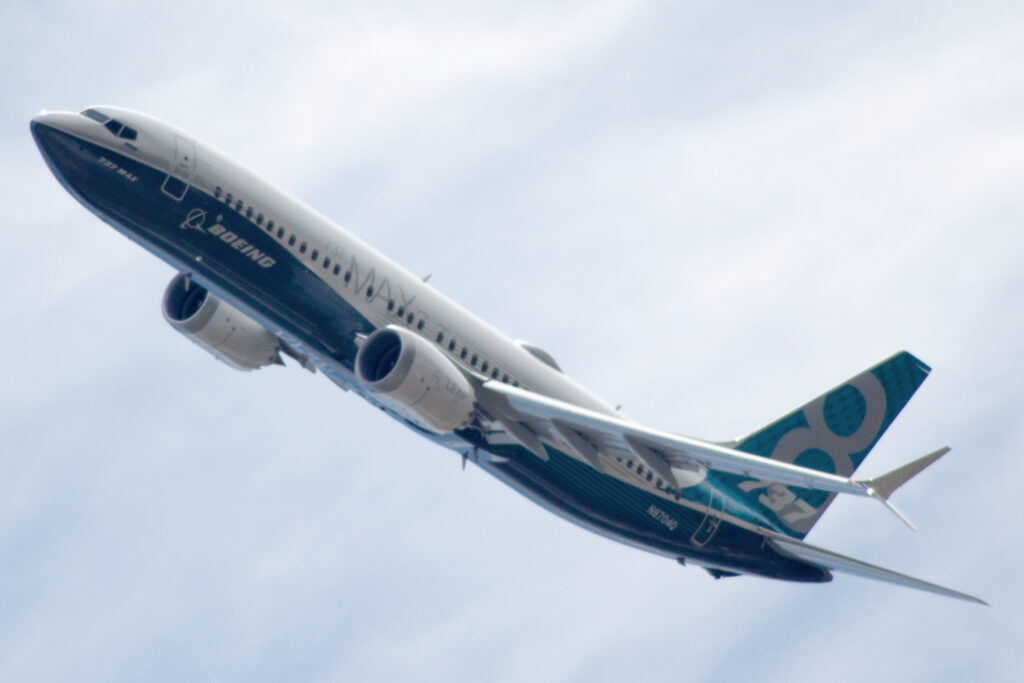
Airbus 320
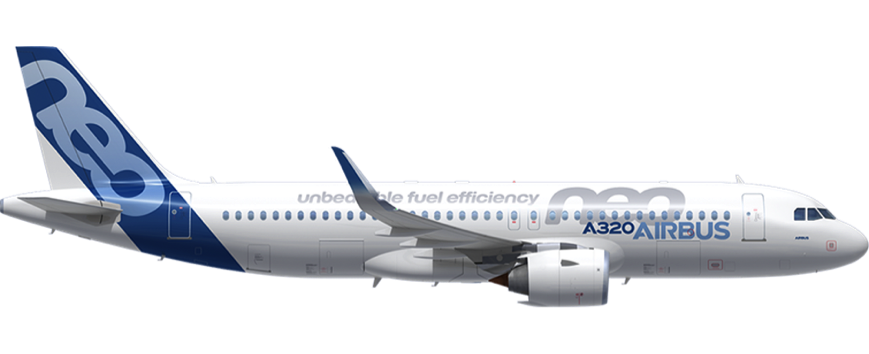
1.0 Executive Summary
Mission
- Phase 1: The mission is to invest in establishing a new low-cost airline dedicated to serving 5 million tourists traveling from North Asia and India to Borneo within a 5-year program.
- Phase 2: Plan to expand the program further, targeting 7.5 million tourists over a 10-year period.

Key Management Team
- Mentors: Mentors are visionary pioneers and industry leaders with a vast global network. They provide invaluable guidance and inspiration.
- Coaches: Coaches are mission-oriented industry experts who offer practical solutions to challenges, ensuring the team stays focused on its objectives.
- Partners:
- A new low cost airline project leader with the strategic vision to lead the unique business model.
- A reputable financier with access to aviation private equity funds.
- Low-cost airline owners that have successful flight and ground operations.
- Target market groups comprising MNC with large employees.
- Hotel, hospitality, tourism and destination attractions stakeholders.
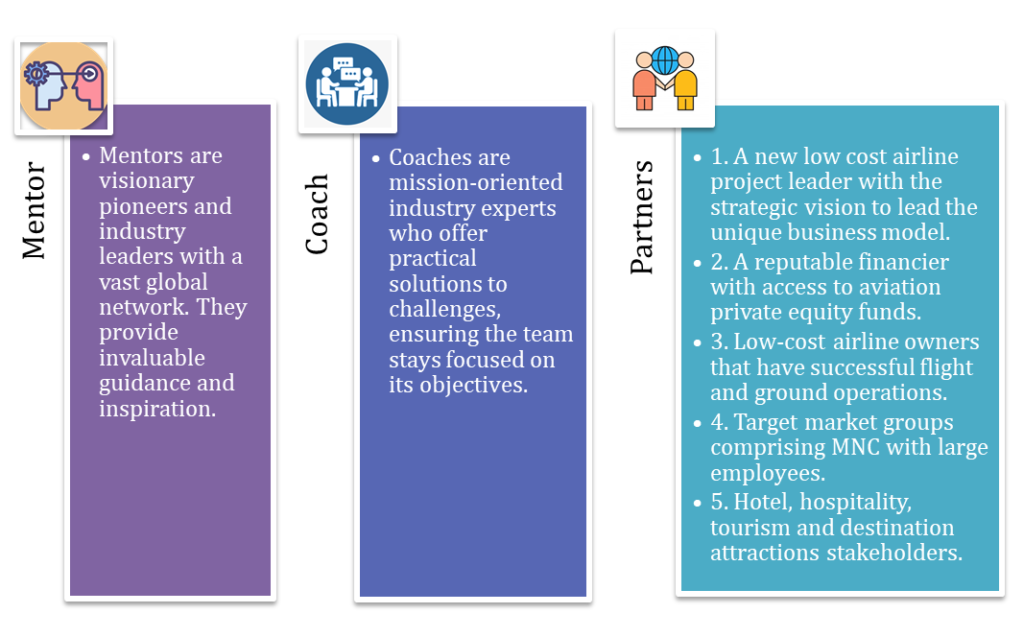
Product Benefits
- Efficiency: Lower capital expenditures and maintain predictable costs by outsourcing operational and business activities.
- Effectiveness: The strategy focuses on optimizing capacity, rationalizing route planning, offering affordable fares, and maximizing profits.
- Quality: Outsourcing ensures a higher quality of service components by eliminating the need for in-house resources.
- Low Cost: The aim is to achieve cost-efficiency through point-to-point connections, fast turnaround times, a single aircraft model, maximum capacity utilization, and fare unbundling.
- Powerful: Alignment with target market groups, airlines, and destination tourism stakeholders will enhance the competitive advantages.

Target Market
- Phase One Key Customers: The initial customer base consists of the largest multinational corporations (MNCs) and State-Owned Enterprises (SOEs) in Asia, totalling 98 million employees across North Asia and India.
Financial Projections
- Total investment: US$1.73 billion
- Production cost: US$1.73 billion/year
- Revenue: US$2.48 billion/year
- Income: US$0.75 billion/year
- Payback period: 1 – 2 years (Collect revenues at booking time)

Unique Business Model
- The aim is to reinforce horizontal and vertical integration through strategic partnerships with target market groups, airlines, destination tourism, and hospitality stakeholders.
- The commitment to offering the lowest pricing assures the target market groups.
- Airlines and tourism stakeholders benefit from the ability to provide reliable tourist numbers and cost structures.
- Private equity fund investors can rely on the business and financial expectations.
- Profits are shared among stakeholders under agreed-upon conditions.
- The unique approach positions the low cost airline as a market leader in this profitable business niche.
2.0 Mission
2.1 Problem
- Declining Passenger Numbers: The year 2020 witnessed the cessation of operations for 34 airlines, and the prevailing gloomy sentiment is expected to persist for the coming years. Full recovery in air travel levels is not anticipated until after 2024.
- Challenges Faced: Airlines serving Borneo Island confront a multitude of challenges, including fierce competition, eroding prices, excess capacity, restricted growth prospects, the limitations of a local market, and unsustainable financial losses.
2.2 Solution
- Establishment of a New Low-Cost Airline: The solution centres on the creation of a new low-cost airline that places paramount importance on:
- Addressing Customer Needs
- Ensuring Financial Viability
- Achieving Operational Excellence
- Offering Charter Flight Services
2.3 Mission
- Phase1:
The mission is to invest in the establishment of a new low-cost airline dedicated to servicing 50% of the 10 million tourists per year traveling from North Asia, India, and the Middle East to Borneo within a 5-year program.
- Phase 2:
Aspire to expand this program, ultimately capturing 50% of the 15 million tourists per year, over a 10-year period.
3.0 Product
3.1 Product Description
- Tourist Focus: The new low-cost airline is dedicated to transporting 50% of the projected 30 million tourists expected to visit Borneo by the year 2050.
- Charter-Based: The airline operates exclusively on the air charter business model.
- Strategic Partnerships: Outsource key certificate, operational, and business activities to low-cost airline partners based in both the host and destination countries.
- Branding: Low-cost airline partners will either own or lease the aircraft, adorned with the low-cost airline’s livery or co-branding.
- Alignment: Aim to foster strategic partnerships with the target market groups, destination tourism, and hospitality stakeholders, ensuring alignment of business and financial goals.

3.2 Product Attributes
- Capital Efficiency (Capex): The low-cost airline substantially reduces capital expenditures (Capex) and overall costs through the utilization of air charter arrangements.
- Revenue Assurance: The strategic alliances with target market groups guarantee a steady influx of passengers, generating a stable cash flow.
- Cost Reduction: The collaboration with the airline industry eliminates redundancy in service teams, thereby reducing operating costs.
3.3 Product Benefits
- Efficiency: Achieve lower Capex by eliminating the need for aircraft ownership and reduce costs through the outsourcing of all operational activities.
- Effectiveness: The approach ensures optimal capacity utilization, rationalized route planning, cost efficiency, affordable fare structures, and sustainable financial profitability.
- Quality: Outsourcing, can lead to a higher quality of service components while eliminating the need for in-house resources.
3.4 Product Competitive Advantages
- Low Cost: The low cost airline has several cost advantages, including point-to-point connections, swift turnaround times, a single aircraft model, maximum capacity utilization, an outsourced workforce, efficient Capex allocation, fare unbundling, and reduced travel times.
- Scope: The charter flights, utilizing the Ultra Low-Cost Carrier (ULLC) model, guarantee a steady flow of passengers, well-planned flight costs, and revenue.
- Powerful: Strengthen the leadership position through partnerships with target market groups, airlines, destination tourism, and hospitality stakeholders, facilitating both horizontal and vertical integration within our operations.
4.0 Market
4.1 Market Segments
The target markets encompass the following regions:
North Asia: Including China, Japan, Korea, Taiwan, and Hong Kong.
India: Encompassing Mumbai, Delhi, Chennai, Hyderabad,
Bangalore, Kolkata.
Middle East: Covering Qatar, Kuwait, Saudi Arabia, Bahrain
and Turkey.
4.2 Target Market Strategy
The primary strategy for capturing the target market revolves around stimulating demand through the provision of frequent and competitive airfares, primarily targeting multinational corporation (MNC) employees in selected cities within North Asia, South Asia, and the Middle East.
China:
- Cities: Target the top 10 cities with the largest populations to establish point-to-point connections. This includes cities such as Shanghai, Beijing, Tianjin, Shenzhen, Chengdu, Chongqing, Xian, Shenyang, and Wuhan, with a combined population of 122.3 million.
- MNCs: Form strategic alliances with MNCs, state-owned, and private enterprises boasting large employee populations to secure 2 million passengers from this demographic.
- Channels: Plan to establish distribution channel arrangements with the largest online travel agency in China and the State Enterprise Tourism Board to secure an additional 1 million passengers annually.
- Positioning Strategy: The positioning strategy emphasises convenience with short flight times (3-5 hours), affordability compared to home cities, diverse Asian cuisine, tropical landscapes including sandy beaches and pristine seas, and the opportunity to explore overseas Chinese culture in Brunei, Indonesia, and Malaysia.
North Asia:
- Cities: The focus is on the top 5 cities by population, including Tokyo, Osaka, Taipei, Hong Kong, and Seoul, which together have a population of 80 million.
- MNCs: Strategic alliances with MNCs, state-owned, and private enterprises will aim to secure 0.5 million passengers.
- Channels: Establish distribution channel arrangements with the largest online travel agencies in North Asia to secure an additional 0.5 million passengers annually.
- Positioning Strategy: Key aspects of the positioning strategy include the convenience of short flight times, diverse Asian cuisine, scenic natural landscapes comprising sandy beaches, pristine seas, mountains, and jungles, as well as the opportunity to explore Japanese and overseas Chinese culture and history in Borneo.
India:
- Cities: Targeting the 6 cities with the highest GDP per capita, including Mumbai, Delhi, Chennai, Hyderabad, Bangalore, and Kolkata, with a total population of 50 million.
- MNCs: Forming strategic alliances with MNCs, state-owned, and private enterprises to secure 0.5 million passengers.
- Channels: Establishing distribution channel arrangements with the largest online travel agencies in India to secure an additional 0.5 million passengers annually.
- Positioning Strategy: The positioning strategy in India emphasizes affordability compared to home cities, diverse Asian cuisine, open spaces, sandy beaches, pristine seas, mountains, and jungles, along with the opportunity to discover local Indian culture.
Travel time
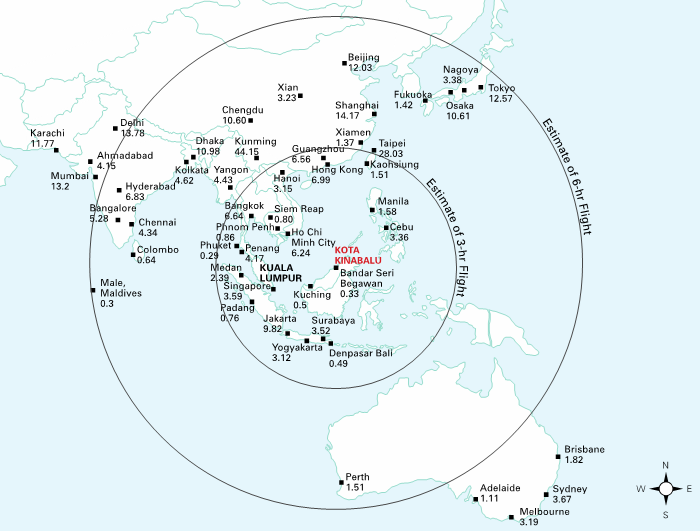
Phase 2
Middle East 1. Cities
- Target the 10 cities with the highest GDP per capita and select 4 hubs for the point-to-point connection.
- Doha (Qatar), Kuwait City (Kuwait), Abu Dhabi, Dubai (United Arab Emirates), Riyadh, Jeddah (Saudi Arabia), Manama (Bahrain), Istanbul, Kocaeli and Ankara (Turkey) together have a total population of 50 million.
2. MNC
- Form strategic alliance with MNC, state and private enterprises that have a large population of employees to secure 0.1 million passengers from this pool.
3. Channels
- Establish distribution channel arrangements with the largest online travel agencies in the Middle East to secure 0.1 million passengers per year from these cities.
4. Positioning strategy
- Islamic food: Best and most variety Islamic food from the global Islamic nations.
- Jungles: Lavish emerald forest
- Assimilation: A journey of discovery of the historical Islamic culture in Brunei, Indonesia and Malaysia.
4.3 Market Needs
2019 visitors to Borneo
- Brunei: 0.3 million
- Sabah: 4.2 million
- Sarawak: 4.7 million
- Kalimantan: 4.4 million (East Kalimantan 2015)
Out of these visitors, 3.5 million were international tourists, while the rest were domestic visitors. This data highlights the substantial demand for travel within the Borneo region, both among domestic and international travellers.
To meet the market needs and achieve the target of 5 million air passengers, a substantial number of trips will be required. For instance, for a Boeing 737 or Airbus A320 plane, each capable of accommodating approximately 150 passengers, 31,250 trips would be necessary. This translates to an equivalent of 86 flights per day.
Brunei visitors 2019

Sabah visitor 2019

Sarawak visitors 2019

4.4 Growth Drivers
- Thriving Economy and Growing Middle Class: The economic prosperity and the expanding middle class in countries like China, India, and various Middle Eastern nations serve as a strong growth driver. As more people in these regions enjoy increased disposable income, they are more likely to engage in international travel, thereby boosting demand for convenient and affordable air travel options.
- Lower Currency in Tourist Destinations: Tourist destinations with favourable exchange rates provide added incentives for travellers. The lower currency rates make these destinations more attractive and affordable for international tourists, further driving demand for flights.
- Borneo’s Popularity as a Tourist Destination: Borneo has gained popularity as a tourist destination, particularly among the North Asia market. The region’s unique attractions, natural beauty, and cultural offerings have led to substantial growth in international passenger traffic. In 2018, the international passenger traffic to Borneo increased by more than 10%, signalling a growing interest in the region.
4.5 Key Customers
China:
1. Multinational Corporations (MNCs): Top 20 MNCs with the largest number of employees, totalling 11.2 million. Agricultural Bank of China Aviation Industry Corp. of China Bank of China China Mobile Communication China Construction Bank China Energy Investment China National Petroleum China Post Group China Railway Construction China Railway Engineering Group China Resources China State Construction Engineering China Telecommunications Hon Hai Precision Industry Industrial & Commercial Bank of China JD Jinneng Holding Group Pacific Construction Group Ping An Insurance Sinopec Group, State Grid. 2. State-Owned Enterprises (SOEs): State-Owned Enterprises in China employ a staggering 35 million individuals, making them a significant customer segment. 3. Private-Owned Enterprises (POEs): The top 500 private-owned enterprises in China have a collective workforce of 10.43 million employees. 4. Public Companies (A-share Listed): Publicly listed companies on the A-share market have a workforce of 26 million employees. 5. Distribution Channels: In reaching these customers, partnering with the largest online travel agencies in China is essential. Prominent players in this space include: Ctrip Fliggy Mafengwo Meituan Qunar Qyer Tuniu. Leveraging these channels can help secure a significant portion of the market share.
Japan:
1. Multinational Corporations (MNCs): Top 53 MNCs in Japan, employing a total of 5.8 million individuals. Toyota Honda Mitsubishi Japan Post Nippon Telegraph and Telephone Itochu Nissan SoftBank Group Hitachi AEON Sony ENEOS Holdings Nippon Life Panasonic Mitsubishi UFJ Dai-ichi Life Mitsui Marubeni Toyota Tsusho Seven & I Holdings Tokyo Electric Nippon Steel Tokio Marine Idemitsu Kosan Sumitomo Mitsui Financial Group Sumitomo Group KDDI MS&AD Denso Mitsubishi Electric Daiwa House Meiji Yasuda Life Mitsubishi Heavy Industries Mizuho Financial Fujitsu Aisin Seiki Sompo Holdings JFE Holdings Mitsubishi Chemical Canon Bridgestone Suzuki Motor Sumitomo Life Insurance Mazda Toshiba Subaru Takeda Pharmaceutical Medipal Holdings Kansai Electric Power Sumitomo Electric NEC Chubu Electric Power East Japan Railway Company 2. Distribution Channels: To effectively reach and serve these customers, collaboration with major online travel agencies in Japan is critical. Prominent players in this space include: Evolable HIS Ikyu Jalan JapanIcan JTB KNT- CT Nippon Travel Rakuten
Korea:
1. Multinational Corporations (MNCs): Targeting the top 14 MNCs in Korea, which employ a combined total of 1 million employees. Samsung Electronics Hyundai Motor SK Holdings POSCO LG Electronics Korea Electric Power Kia Motors Hanwha Hyundai Mobis KB Financial CJ Corporation GS Caltex Samsung Life Insurance Samsung C&T 2. Distribution Channels: To effectively reach and cater to these customers, partnering with leading online travel agencies in Korea is essential. Prominent players in this space include: Yanolja Daily Hotel Hana Tour Interpark Tour Privia travel Mode Tour DR Travel Online Tour MyRealTrip
Taiwan:
1. Multinational Corporations (MNCs): Targeting the top 9 MNCs in Taiwan, which employ a combined total of 1.33 million employees.
Hon Hai
Pegatron
Taiwan Semiconductor
Cathay Financial
Quanta Computer
Compal Electronics
Fubon Financial
CPC
Wistron
2. Public Companies (Listed): There are 17 listed companies in Taiwan that have more than 10,000 employees.
3. Distribution Channels: To effectively reach and serve these customers, partnering with major online travel agencies in Taiwan is essential. Prominent players in this space include:
ezTravel
Star Travel
Ezfly
Lion Travel
Cola Tours
Hong Kong:
1. Multinational Corporations (MNCs): Top employers with 1.1 million employees are: Jardine Matheson Hong Kong Government HSBC Hutchison Whampoa The top 75 companies with the largest employees: A. S. Watson AIA AXA Bank of America Merrill Lynch Bank of China Bank of East Asia BNP Paribas Café de Coral Cathay Pacific CBRE China CITIC Bank China Construction Bank (CCB) China Mobile China Overseas Chow Sang Sang Citibank CLP Power Hong Kong Limited Credit Suisse Cushman and Wakefield Dah Sing Bank Dairy Farm (7-Eleven, Ikea, Mannings, Wellcome, Oliver's) DBS Bank Deloitte Deutsche Bank DFS Group DHL Disneyland Ernst & Young Esteé Lauder FedEx Gammon Construction Goldman Sachs Hang Lung Development Hang Seng Bank Henderson Land Development HK Broadband Network HK Electric HKT Hong Kong International Terminals Hong Kong Jockey Club HSBC, Hsin Chong Group IBM ICBC J.P. Morgan Jardine Engineering Corporation (JEC) Jones Lang Lasalle KFC KPMG Lane Crawford (HK) Limited Leighton Li & Fung Group Manulife International Maxim's McDonald's Morgan Stanley MTR New World Development OCBC Ocean Park Corporation PCCW Solutions Pizza Hut Prudential PwC SmarTone Société Générale Standard Chartered Bank Sun Hung Kai Properties Swire Properties The Hong Kong and China Gas Company The Kowloon Motor Bus Co. The Orient Overseas Container Line UBS Bank Wing Lung Bank. 2. Distribution Channels: CheapTickets CTSHK Hong Thai Travel Hutchgo Morningstar Travel TravelLiker Wing On Travel
India:
1. Multinational Corporations (MNCs): Top 15 MNCs and PSUs with the largest employees, at 5.9 million. Indian Railways Sahara India Pariwar Tata Consultancy Services India Post QUESS Corp Coal India State Bank of India Infosys Reliance Industries Wipro HCL Tech Mahindra IBM HDFC Bank Punjab National Bank. 2. BSE-500 (Bombay Stock exchange): Top 500 listed companies with 6 million employees comprising PSU (Public Sector Enterprises) 1.5 million and private sector at 4.5 million. The top 25 companies have 3 million employees. 3. IT: Top IT companies in India with 2.86 million employees. Accenture Capgemini Genpact HCL Hexaware IBM Infosys L & T InfoTech Mindtree Mphasis Oracle Tata Consultancy Services Tech Mahindra Wipro 4. Distribution Channels: Largest online travel agencies are: Cleartrip EaseMyTrip Ixigo MakeMyTrip Musafir Travelguru Via Yatra.
Phase 2
Middle East:
1. Multinational Corporations (MNCs): Top MNCs with the largest employees, at 0.5 million. Qatar National Bank Industries Qatar National Bank of Kuwait Kuwait Finance House Zain Agility Logistics First Abu Dhabi Bank Emirates Telecommunications Group DP World Emirates NBD SABIC Saudi Telecom Company Al-Rajhi Bank National Commercial Bank Saudi Electricity Saudi Arabian Mining Al Baraka Banking Group KOC Holding BİM Supermarkets Türk Telekom 2. Distribution Channels: Largest online agencies are: Almosafer Flypgs Flyin Holidayme Musafir Rehlat Tajawal Turkish Airlines Yamsafer
4.6 Competition and Industry
Understanding the competitive landscape and the existing players in the industry is crucial for the low-cost airline’s success. Here are the national airlines that currently operate flights to Borneo:
Brunei:
- Royal Brunei Airlines
Malaysia:
- Air Asia (Air Asia/AsiaX)
- Malaysia Airlines (MAS / Firefly / MASwings)
- Malindo Air
- MYAirline
Indonesia:
- Airfast Indonesia
- Aviastar
- EastIndo
- Garuda Group (Garuda Indonesia / Citilink / Sriwijaya Air / Nam Air)
- Indonesia AirAsia
- Indonesia Air Transport
- Lion Air Group (Lion Air / Batik Air / Wings Air / Malindo Air / Super Air Jet)
- Pelita Air
- Premiair
- Susi Air
- TransNusa Aviation
- Trigana Air
The presence of established national airlines in the region poses competition for the low-cost airline. To succeed, implement differentiate strategy by offering competitive pricing, excellent customer service, and unique value propositions. Leveraging strategic partnerships can also enhance the competitive edge in the market.
Additionally, staying updated with industry trends, maintaining a strong focus on safety and quality, and continuously improving the services will be essential for success in the competitive aviation industry, especially in the context of serving Borneo as a popular tourist destination.
Market share for Brunei
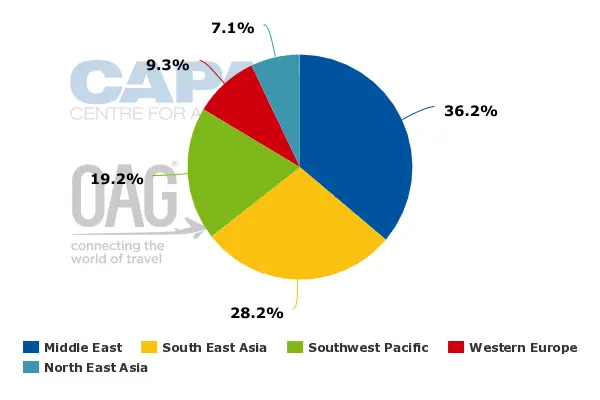
Malaysia market share

Indonesia market share
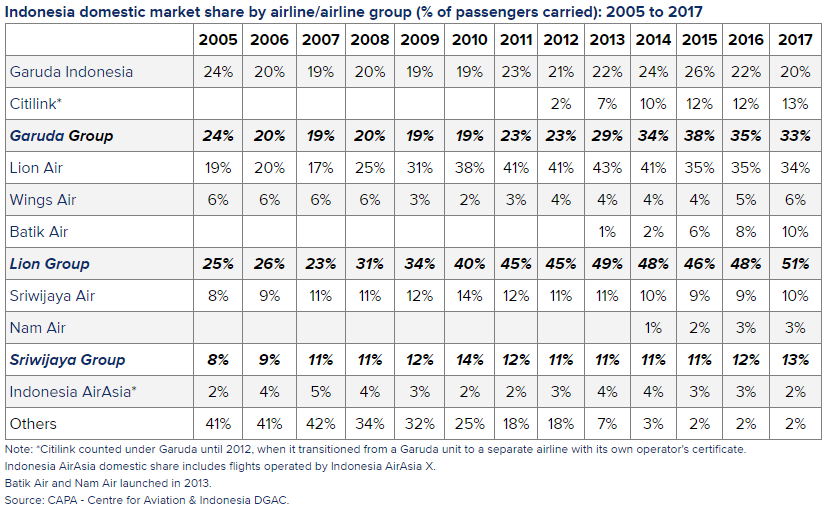
Competition:
- The example of US aviation deregulation in 1978, which led to the creation of 120 new startup airlines, demonstrates how competition can be intense in the industry.
- The fact that only two or three of those startups survived over the long term underscores the difficulty of establishing and maintaining a successful airline operation.
Startup Trends:
- Between June 2020 and June 2021, there were 36 new startup airlines globally. This indicates ongoing interest and entrepreneurial activity in the aviation sector.
- The Asia Pacific region, with eight planned startup airlines during this period, shows a significant focus on the airline industry in this region.
Failure Trends:
- In 2020, the aviation industry faced substantial challenges due to the COVID-19 pandemic, leading to financial difficulties for many airlines.
- The bankruptcy of 34 airlines in 2020 highlights the vulnerability of airlines to external shocks, such as the global health crisis.
5.0 Operation
Operational efficiency and execution are critical for the success of your low-cost airline venture. Here’s a breakdown of the key operational aspects:
5.1 Charter Flights
Charter flight operations involve specific unscheduled itineraries catering to different holiday packages for the target tourists:
- Single Entity: In this scenario, MNCs will pay for the operation of an entire airplane trip on behalf of their employees. This approach ensures dedicated flights for corporate entities.
- Special Events: Charter flights serve as a common mode of transport for special food, cultural, sports events, and attractions. These flights provide tailored travel solutions for events.
- Public Charters: Public charter flights are offered as part of vacation packages, providing excellent value and nonstop flights for leisure travellers.
5.2 Secure Passengers
Securing passengers is vital for the success of the charter flights:
- MNCs: Establish direct contracts with MNCs and secure passenger numbers using the targeted market strategy, especially for corporate clients.
- Special Events: Forge direct contracts with affinity agencies that cater to specific events to secure target passengers for those occasions.
- Public Charters: Secure passengers for public charter demands through online agencies and distribution channels that cater to vacation package deals.
5.3 Operation
Efficient and seamless operations are essential for customer satisfaction and cost management:
- Outsource: Consider adopting an outsourcing model where you outsource all flight operations, management, and maintenance to low-cost airline partners. This model is akin to the ACMI (Aircraft, Complete Crew, Maintenance, and Insurance) model, which can help reduce operational costs and improve efficiency.
- Departure: Strategic airline partners in the host countries should handle all departure procedures, ensuring smooth and efficient boarding processes for passengers.
- Arrival: Collaborate with strategic hotel partners to organize all accommodation needs upon passengers’ arrival. Ensuring a comfortable and hassle-free arrival experience contributes to overall customer satisfaction.
6.0 Financial Implications
6.1 Investment Segments
The target market consists of cost-conscious tourism and holiday travelers, with a specific focus on MNCs in North Asia, India, and the Middle East:
- Phase 1: The goal is to invest in a new low-cost airline to service 50% of the 10 million tourists/year from North Asia, India, and the Middle East to Borneo. This is part of a 5-year program.
- Phase 2: The expansion program aims to capture 50% of the 15 million tourists/year over a 10-year period.
Investment Cost:
- Phase 1: To accommodate 5 million passengers at a rate of US$230 per passenger, the estimated cost is US$1.15 billion.
- Phase 2: For 7.5 million passengers at the same rate of US$230 per passenger, the estimated cost is US$1.73 billion.

6.2 Production Cost
- Phase 1: To accommodate 5 million passengers at a rate of US$230 per passenger, the estimated annual production cost is US$1.15 billion.
- Phase 2: For 7.5 million passengers at the same rate of US$230 per passenger, the estimated annual production cost is US$1.73 billion.

Investment and production costs depend on many variable factors. The estimate below is based on the Boeing 737-800 flight from Shanghai to Kota Kinabalu as a guide. Actual costs will vary from this projection. Turnaround time is most efficient at 25 minutes.
Operation cost: Case studies
Option 1: Cost to airline owner/operator
Boeing 737-800: 160-175 passengers, range 4,667 km,
costs US$3,454– US$4,469/hour.
Airbus 320: US$2,966–US$5,590/hour
Industry average: US$5,000/hour
Total operating: US$8,916/hour
Air Carrier Cost – Direct and Indirect Costs

Cost per block hour

Option 2: Commercial charter flight cost
Charter 737-88 : US$2,966–US$5,590/hour

6.3 Prices and Revenues
- Phase 1: With a target of accommodating 5 million passengers at a rate of US$330 per passenger, the estimated annual revenue is US$1.65 billion.
- Phase 2: For the expanded program aiming to serve 7.5 million passengers at the same rate of US$330 per passenger, the estimated annual revenue is US$2.48 billion.

Case studies
Option 1: Competitor - Commercial flights
Route: Shanghai to Kota Kinabalu (2021)
Flights time: 17 hours (2 stops)
Published prices: US$265–1587
October price: US$471
Option 2: Commercial charter flight
Route: Shanghai to Kota Kinabalu (2021)
Charter flights time: 3 hours 41 minutes (Direct) + 1 hour
turnaround time
Estimated cost: US$490 (US$19,150
X 4.10 hours/160 passengers)
Proposed price: US$534 (9% margin)
Option 3: Outsource charter flight
Route: Shanghai to Kota Kinabalu (Oct 2021)
Charter flights time: 3 hours 41 minutes (Direct) + 1-hour
turnaround time
Estimated cost: US$230/passenger ($9,000
X 4.10 hrs. /160 passengers)
Proposed price: US$330/passenger
Profit share: US$100/passenger (US$50 each to the
virtual airline and airline operator)
Option 3 benefits
MNC: Enjoy flexible travel, shorter time and distance, direct
point-to-point travel, competitive pricing, privacy,
prestige, employee loyalty.
Airline: Achieve full capacity, lower overall operation cost,
competitive advantages and profit.
Low Cost Airline: Secure the target market and experience growth
in selected target segment.
Stakeholder: Guarantee tourists and generate revenues for the
destination tourism stakeholders.
Forbes’ World’s biggest public airline companies by revenue 2020
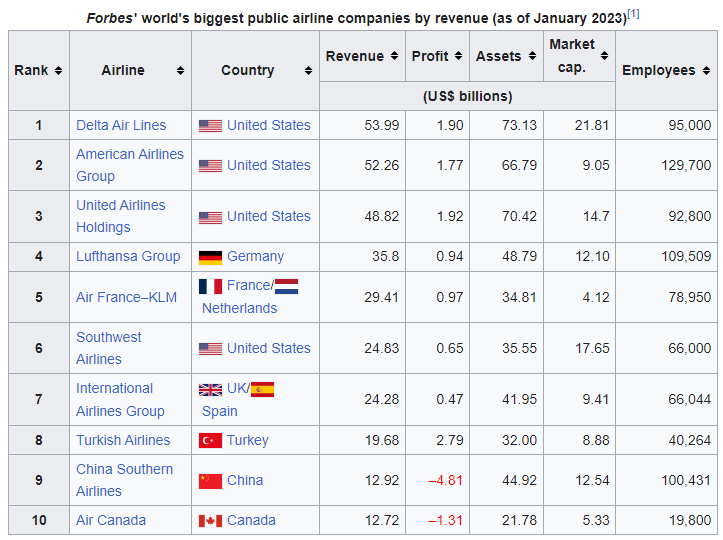
6.4 Financial Returns
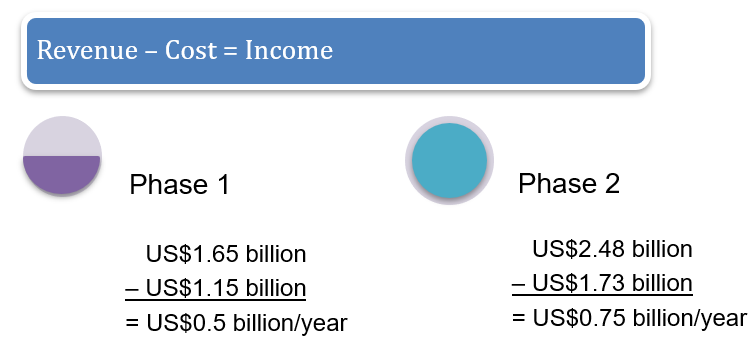
Case studies of the global airline industry performance.
Global comm. airlines 2015 2016 2017 2018 2019 2020F 2021F
Return on invested cap. % 7.9 7.2 6.8 6.5 5.8 -16.9 -4.9
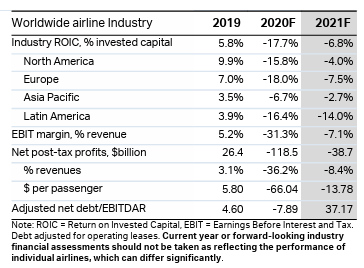
2019 Financial Income of charter airline and low-cost airline public listed companies:
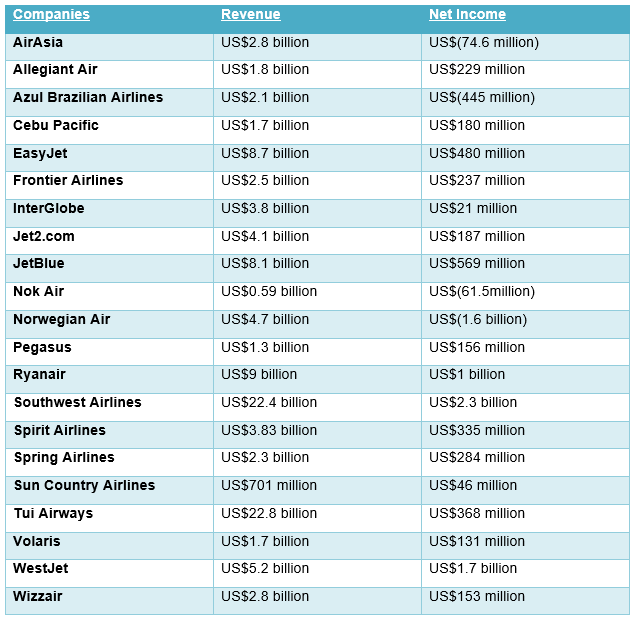
Source: https://www.wsj.com/market-data/quotes/company-list
6.5 Source of Funding
1. Strategic investors
- New Low-Cost Airline Investor (Project Leader): This individual or group will take on the role of the project leader with a focus on business and financial management. They will play a pivotal role in overseeing the startup and ongoing operations of the airline.
- Financier (Aviation Private Equity Group): Aviation private equity groups specialize in investing in aviation-related ventures. They can provide the necessary financial resources to kickstart the airline and support its growth.
- Airline Owner/Operator: This entity will be responsible for managing the flight and ground operations of the airline. They may have a financial stake in the venture and will ensure that the airline operates efficiently and safely.
- MNCs (Target Market Groups with Financial Interest): By forming strategic alliances with MNCs that have a financial interest in the venture, you can secure additional funding. These MNCs may see value in supporting an airline that caters to their employees’ travel needs.
- Destination Tourism Stakeholders (Hotels and Tourism Attractions): Collaboration with stakeholders in the destination tourism industry, such as hotels and tourism attractions, can also contribute to funding. These stakeholders have a vested interest in attracting more tourists to the region and can provide financial support.
2. Private equities and investors
Abrdn Investment Management AerCap Holdings, APG Asset Management Apollo Global Management Artisan Partners Attestor Capital AustralianSuper Avia Solutions Group Bain Capital Baillie Gifford & Co BlackRock Blackstone Boeing Capital Corporation Caelum Investments Canaccord Genuity Capital Group Capital A Cascade Investment Castlelake Causeway Capital Management CDB Aviation Centerbridge Partners Cerberus Capital Management Certares Management Columbia Threadneedle Comgest Credit Suisse Asset Management CVC Capital Partners Cyrus Capital Partners Diamond Hill Capital Management Dimensional Fund Advisors DNB Asset Management EQT Partner Esas Holding Fidelity First Eastern Investment Group Folketrygdfondet, Fortress Investment Group Franklin Templeton GE Capital GIC Global Infrastructure Management Gobi Investment Partners GOL Linhas Aereas Inteligentes Handelsbanken Asset Management Hargreaves Lansdown Harris Associates IFC Emerging Asia Fund IFM Investors, Indigo Partner Investec Aviation Funds Janus Henderson Investors Jennison Associates JPMorgan Investment Management Jupiter Asset Management KKR Knighthead Capital Management Kotak Mahindra Asset Management Lazard Asset Management Legal & General Investment Management Macquarie AirFinance Massachusetts Financial Services Matthews International Capital Management Merrill Lynch International MFS International Neuberger Berman Investment Ninety One Nordea Investment Management Norges Bank Investment Management Nomura Securities Oak Hill Capital OakTree Capital Management Onex Corp PAR Capital Management Permian Investment Partners Phoenix Asset Management Partners Platinum Investment Management Primecap Management Putnam Investment Management QSuper Reed Smith RPK Capital Ruffer SBI Funds Management Schroder Investment Management Silver Point Capital Small Cap World Fund Société Générale SA SSgA Funds Management State Capital Investment Corporation Sundt AS Sydney Airport Holdings Terra Firma Thrivent Asset Management TimesSquare Capital Management Teewinot Capital Advisers UBS Asset Management US Global Investors Vanguard Group Victory Capital Management Wasatch Advisors Wellington Management Western Asset WestBridge Capital Partners William Blair
3. Consultants, development and funding managers to the airline industries:
- ABL Aviation: Provides consulting services in aircraft leasing and aviation finance.
- Alton Aviation: Offers advisory services specializing in aviation and aerospace.
- Alvarez & Marsal: A global consulting firm known for its expertise in various industries, including aviation.
- Aviation Finance: Specializes in financial solutions and advisory services for the aviation sector.
- Aviation Strategy: Provides strategic consulting services for airlines and aviation-related businesses.
- BCG (Boston Consulting Group): A renowned management consulting firm with expertise in aviation and transportation.
- CAPA (Centre for Aviation): Offers research, analysis, and consulting services in the aviation industry.
- Carlyle Aviation Partners: A global investment firm with a focus on the aviation sector.
- Deloitte: A multinational professional services firm offering consulting and advisory services for airlines.
- Emerton: Provides management consulting services, including strategy and operational improvement.
- Ernst & Young (EY): Offers a wide range of consulting and financial services, including those tailored to the aviation industry.
- Global Aviation: Specializes in aviation consulting, market analysis, and advisory services.
- IATA (International Air Transport Association): Represents the global airline industry and offers valuable industry insights.
- IBS Software Services: Provides software solutions and services for the aviation industry.
- KPMG: A leading global network of professional firms offering audit, tax, and advisory services, including those for airlines.
- LEK Consulting: Provides management consulting services with expertise in aviation and transportation.
- Lufthansa Consulting: Offers consulting services with a focus on the aviation sector.
- McKinsey & Company: A global management consulting firm known for its expertise in aviation and transportation.
- Mott MacDonald: Provides engineering, management, and development consultancy services, including those related to aviation.
- PA Consulting Group: Offers consulting and innovation services with applications in the aviation industry.
- PwC (PricewaterhouseCoopers): Provides a wide range of professional services, including consulting, for the aviation sector.
- The Airline Analyst: Offers financial analysis and advisory services specific to the airline industry.
- Watson Farley & Williams: An international law firm with expertise in aviation and transport-related legal matters.
6.6 Additional Opportunities
Mass market tourists will skim on their travel expenses. Therefore the profit margin is at par with the industry benchmark – reasonable but not excessive. However, the Asian tourists will allow themselves to be generous when it is food and shopping time.
- Shopping Malls: Asian tourists, in particular, tend to be generous when it comes to shopping. They often allocate a significant portion of their travel budget to buying souvenirs, fashion items, electronics, and other goods. This presents a lucrative opportunity for your business. By strategically partnering with shopping malls or offering exclusive shopping deals and incentives to your passengers, you can tap into this revenue stream.
- Food Centers: Food is a significant aspect of the travel experience for many tourists, and Asian tourists are known for their appreciation of diverse cuisines. By collaborating with local restaurants, eateries, and food vendors at your destination, you can enhance the dining experience for your passengers and generate additional revenue through commissions or partnerships.
7.0 Management Team
7.1 Key Management Team
- Mentor:
Mentors are visionary pioneers and industry leaders with a vast global network. They provide invaluable guidance and inspiration.
- Coaches:
Coaches are mission-oriented industry experts who offer practical solutions to challenges, ensuring the team stays focused on its objectives.
- Partners:
1. A new low-cost airline project leader with the strategic vision to lead the unique business model.
2. A reputable financier with access to aviation private equity funds.
3. Low-cost airline owners that have successful flight and ground operations.
4. Target market groups comprising MNC with large employees.
5. Hotel, hospitality, tourism and destination attractions stakeholders.
In the airline industry, several global leaders have made significant contributions, shaping its growth and success. Here is a list of some of these remarkable individuals, honoured for their vision and dedication:
- Sir Richard Branson
- Professor Rigas Doganis
- Tan Sri Dr. Tony Fernades
- Rakesh Gangwal
- James Halstead
- Gary C. Kelly
- Rusdi Kirana
- Conor McCarthy
- David Neeleman
- Michael O’Leary
- Malcolm Ramsay
- Jane Sun
These are just a few of the outstanding professionals and captains of the industry. The readers are encouraged to explore further and conduct their research to learn more about the management teams in this dynamic field.
7.2 Key Management Team Model
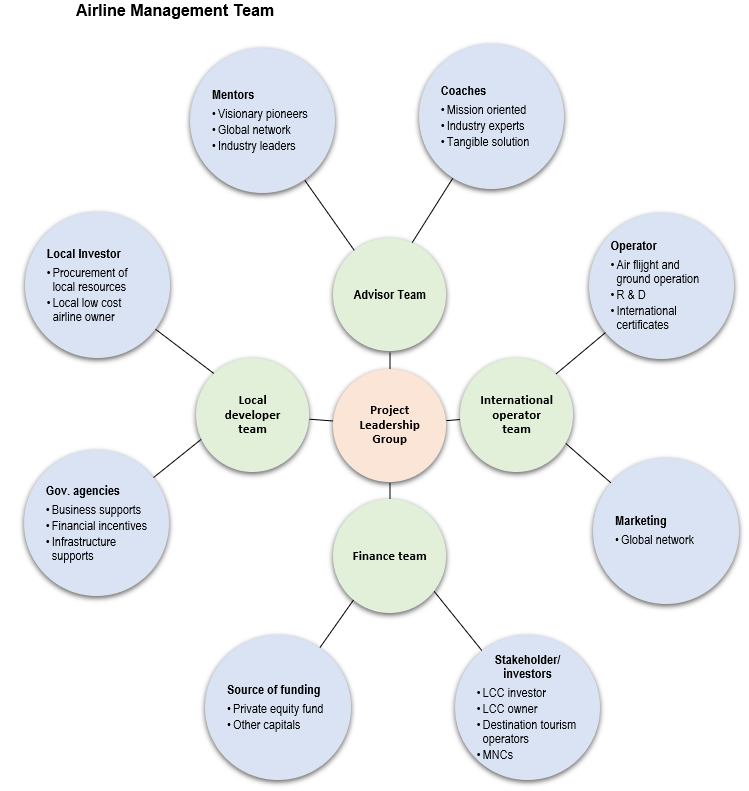
8.0 Unique Business Model
8.1 Successful Track Record
Having strategic partners with a successful track record in the airline, hospitality, and destination tourism industry is a significant advantage. Their past achievements and expertise can provide several benefits:
- Experience: Partners with a successful track record bring valuable industry experience and knowledge to the venture.
- Credibility: Their past successes enhance the credibility of the new low-cost airline and build trust among customers and investors.
- Network: Established partners often have extensive networks within the industry, which can open doors to valuable connections, resources, and opportunities.
- Best Practices: Learning from their previous successes allows for the implementation of best practices and strategies that have proven effective in the industry.
8.2 Entry Model
The entry model, which involves a strategic partnership with existing low-cost airline owners and operators, offers several advantages:
- Specialisation: It allows each entity to focus on its core strengths. Low-cost airline operators can handle flight and ground operations efficiently, while the new low-cost airline can concentrate on marketing and sales.
- Efficiency: This model can lead to cost savings and operational efficiency as responsibilities are divided based on expertise.
- Guaranteed Capacity: The charter flight model ensures full capacity, reducing the risk of underutilized flights and maximizing revenue potential.
8.3 Unique Business Model
The unique business model, characterized by strategic partnerships with target market groups, low-cost airlines, destination tourism, and hospitality stakeholders, provides several competitive advantages:
- Integration: Horizontal and vertical integration with various stakeholders strengthens the overall business ecosystem and enhances competitiveness.
- Low Pricing Assurance: Target market groups benefit from the assurance of the lowest pricing, making your airline an attractive choice.
- Data and Insights: Collaboration with airline operators and tourism stakeholders provides access to valuable data on tourist numbers and cost structures, enabling data-driven decision-making.
9.0 Key Success Factors & Risk Mitigation
9.1 Key Success Factors
Key success factors are critical elements that contribute to the achievement of your airline venture’s goals. Here are the identified key success factors for your low-cost airline:
- Low Cost: Efficient operations with short turnaround times, point-to-point services, a fleet consisting of single aircraft types, optimized capacity utilization, ‘unbundled’ fares, limited passenger services, high aircraft utilization rates, lean management, and utilizing secondary airports all contribute to maintaining a competitive low cost structure.
- Bolt-On Strategy: Partnering and aligning with leading low-cost airlines like Air Asia and Lion Air can facilitate rapid market entry and benefit from the experience and expertise of these established players.
- Team: Collaborating with target market groups, low-cost airlines, financiers, and hospitality stakeholders creates a network of support and expertise that increases the likelihood of success.
9.2 Risks
Identifying and addressing risks is crucial for the resilience of your airline venture. Here are the identified risks:
- Mandatory Quarantine: Mandatory quarantine measures can significantly impact the airline industry by deterring travellers. This risk can disrupt operations and reduce passenger demand.
- Regulatory Settings: Regulatory constraints that limit pricing flexibility and business growth can impede the airline’s ability to compete effectively and achieve profitability.
- Market Trends and Passenger Concerns: Market trends and changing passenger concerns, such as health and safety considerations, can affect demand patterns and passenger behaviour.
9.3 Risk Mitigation
To mitigate these risks, specific actions and strategies can be employed:
- Prevention: Implement measures to prevent passengers with coronavirus symptoms from traveling. Conduct temperature screening procedures at airports to identify potential cases. Advocate for the elimination of mandatory quarantine by working closely with relevant authorities.
- Domestic Travel Markets: As a response to travel restrictions, consider kick-starting domestic travel markets as a first step to reactivate the industry. Regional markets can serve as a testing ground for recovery efforts.
- Health and Safety Programs: Implement comprehensive health and safety programs for passengers and employees. Effectively communicate these measures through marketing campaigns to reassure passengers of their safety when flying.
10.0 Exit Strategy
10.1 Forms of Exit
- IPO (Initial Public Offering): Investors sell their shares as part of the IPO to the public, allowing the airline to become a publicly traded company.
- M&A (Mergers and Acquisitions): The airline can be acquired by another airline as a strategic acquisition.
- Sale: Investors have the option to sell the company to another private equity firm.
- Buyback: Management of the company may choose to buy back the equity stake from private investors.
10.2 Benefits of the Business to New Investors
- Market: The airline targets growing middle-class markets in North Asia, India, and the Middle East, presenting opportunities for continued growth.
- Revenue: The business generates recurring revenue that can align with the growth of the target markets.
- Price: Competitive pricing strategies can help attract and retain customers.
- Risk: The airline’s secure demand and price structure reduce exposure to financial risks.
- Product: Expansion to new destination tourism attractions can attract repeat customers and diversify the product offering.
- Opportunity: New investors can capture the opportunities presented by entering a new market and increasing additional revenue.
- Exit: The exit strategy is planned after the fifth year when the business and cash flow are stable, offering a favourable timing for investors.
10.3 Attraction of the Business to New Investors
- Market: Acquiring the airline can help new investors capture additional market share in the Asia Pacific regions.
- Cost: An acquisition provides the opportunity to explore cost-saving synergies and improve overall performance.
- EBITDA: The airline’s competitive advantages, such as vertical integration, can enhance EBITDA (Earnings Before Interest, Taxes, Depreciation, and Amortization) and bottom-line performance.
- Leadership: New investors can bring in a new leadership team to drive improvements in business and financial performance.
- Distribution: The acquisition can provide access to new markets, tourism products, and distribution channels.
- Revenue: The addition of the airline to an investor’s portfolio can lead to additional revenue opportunities.
10.4 Winning Strategy
- Strategy: The vertical integration model and business alliances with stakeholders are identified as winning strategies, ensuring a strong market presence and collaboration within the industry.
- Team: A powerful management team consisting of top global players enhances high-quality management practices and profitable operations.
- Win-Win: The business aims for profitability with shared rewards among stakeholders, creating a win-win situation for all parties involved.